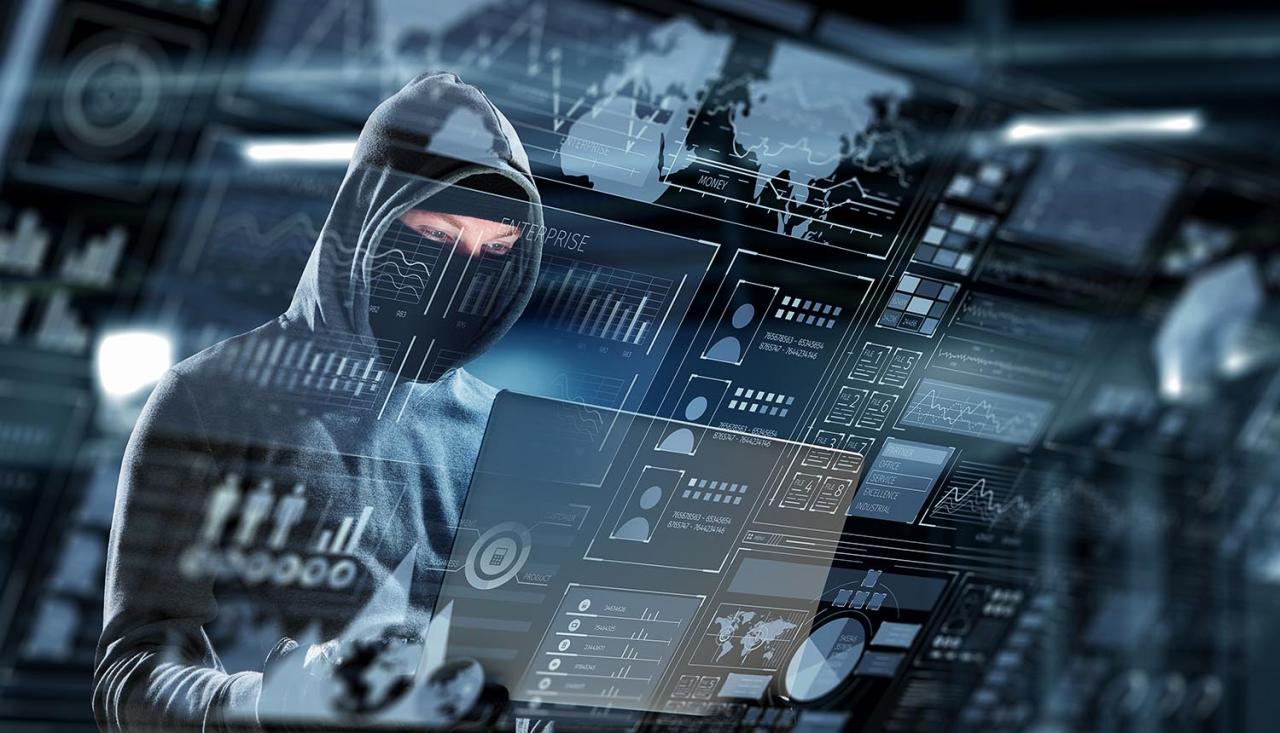Technology and Crime: A Shifting Landscape
Technology and crime are intertwined in a dynamic and ever-evolving relationship. Throughout history, technological advancements have often been exploited for criminal purposes, from the use of forged documents in the […]

Technology and crime are intertwined in a dynamic and ever-evolving relationship. Throughout history, technological advancements have often been exploited for criminal purposes, from the use of forged documents in the 19th century to the sophisticated cyberattacks of the 21st century. The digital age has ushered in a new era of crime, with cybercriminals leveraging the internet and its interconnected networks to commit a wide range of offenses.
This exploration delves into the intricate relationship between technology and crime, examining how technology has shaped criminal activity, the impact of cybercrime, and the role of technology in crime prevention and detection. We will also discuss the challenges and opportunities facing law enforcement in the digital age and speculate on the future of technology and crime.
Cybercrime and Digital Threats
The digital landscape has transformed the way we live, work, and interact, but it has also created new avenues for criminal activity. Cybercrime encompasses a wide range of illegal activities conducted using computers and the internet. These threats pose significant risks to individuals, businesses, and governments worldwide.
Types of Cybercrime
Cybercrime encompasses various activities, each with unique characteristics and consequences. Here are some of the most prevalent types:
- Hacking: Unauthorized access to computer systems or networks. Hackers may exploit vulnerabilities in software, use brute-force attacks, or employ social engineering tactics to gain entry. They may steal data, disrupt operations, or launch further attacks.
- Phishing: Deceitful attempts to obtain sensitive information, such as login credentials, credit card details, or personal data, by impersonating legitimate entities through emails, websites, or text messages. Phishing attacks often exploit social engineering techniques to trick victims into revealing their information.
- Malware: Malicious software designed to harm computer systems or steal data. This includes viruses, worms, trojan horses, ransomware, and spyware. Malware can spread through infected files, email attachments, or malicious websites. It can corrupt data, disable systems, or provide unauthorized access to sensitive information.
- Ransomware: A type of malware that encrypts a victim’s data and demands payment for its decryption. Ransomware attacks can cripple businesses, disrupt critical services, and cause significant financial losses.
Methods and Techniques
Cybercriminals employ a variety of methods and techniques to carry out their attacks:
- Social Engineering: Exploiting human psychology to manipulate victims into revealing sensitive information or granting access to systems. This can involve impersonating trusted individuals, creating fake websites, or using deceptive tactics to gain trust.
- Exploiting Vulnerabilities: Identifying and exploiting weaknesses in software, operating systems, or network configurations to gain unauthorized access or control. These vulnerabilities can be found in software bugs, outdated systems, or misconfigured security settings.
- Brute-Force Attacks: Trying numerous combinations of passwords or login credentials until a successful match is found. These attacks can be automated and can exploit weak passwords or inadequate security measures.
- Denial-of-Service (DoS) Attacks: Overwhelming a target system with traffic requests, preventing legitimate users from accessing it. These attacks can disrupt online services, websites, or networks, causing downtime and financial losses.
Impact of Cybercrime
Cybercrime has far-reaching consequences, affecting individuals, businesses, and governments:
- Financial Losses: Cybercriminals can steal money directly through fraud, ransomware, or identity theft. They can also cause financial losses through data breaches, system downtime, and reputational damage.
- Data Breaches: Cyberattacks can lead to the theft or compromise of sensitive personal, financial, or proprietary data. This can result in identity theft, fraud, and reputational damage.
- Disruption of Services: Cyberattacks can disrupt critical infrastructure, such as power grids, transportation systems, or healthcare networks. This can have severe consequences for public safety, economic stability, and national security.
- Erosion of Trust: Cybercrime can erode public trust in digital systems and institutions. This can discourage individuals from using online services, hinder innovation, and undermine economic growth.
Technology’s Role in Crime Prevention and Detection: Technology And Crime

Technology has revolutionized the way we approach crime prevention and detection, offering innovative tools and strategies to enhance public safety. From sophisticated surveillance systems to advanced data analysis techniques, technology plays a crucial role in deterring criminal activity and bringing perpetrators to justice.
Surveillance Systems
Surveillance systems are a fundamental component of crime prevention and detection, employing various technologies to monitor public spaces and gather evidence.
- Closed-circuit television (CCTV) cameras are widely deployed in urban areas, providing real-time monitoring of streets, public transportation, and other high-traffic locations. They act as a deterrent and provide valuable footage for investigations.
- Body-worn cameras are becoming increasingly common among law enforcement officers, offering an objective perspective on interactions with the public and providing evidence in cases of misconduct or disputes.
- Drone surveillance is gaining traction for aerial monitoring of large areas, particularly in disaster situations or for search and rescue operations. They can provide real-time video feeds and thermal imaging, aiding in the detection of suspects or missing persons.
Facial Recognition
Facial recognition technology utilizes algorithms to identify individuals based on their facial features, offering potential applications in crime prevention and detection.
- Security checkpoints at airports and other high-security locations can leverage facial recognition to quickly identify individuals on watchlists or with outstanding warrants.
- Missing persons investigations can benefit from facial recognition to match unidentified remains or individuals captured in surveillance footage with missing persons databases.
- Law enforcement agencies can use facial recognition to identify suspects in crime scenes, analyze crowds during protests, and track the movement of individuals of interest.
DNA Databases
DNA databases store genetic profiles of individuals, primarily collected from convicted criminals or crime scenes. They play a vital role in identifying suspects and solving crimes.
- DNA profiling is a powerful tool for linking suspects to crime scenes, exonerating wrongly convicted individuals, and identifying missing persons. It has been instrumental in solving cold cases and bringing perpetrators to justice.
- National DNA databases allow for the comparison of DNA profiles across jurisdictions, facilitating cross-border investigations and identifying serial offenders.
- Familial DNA searching involves comparing DNA samples from crime scenes to the DNA profiles of relatives in the database, potentially leading to the identification of suspects even if their own DNA is not in the system.
Ethical Considerations
The use of technology for crime prevention and detection raises significant ethical considerations.
- Privacy concerns arise from the collection and analysis of personal data, including facial recognition and surveillance footage. It is crucial to ensure that these technologies are used responsibly and with appropriate safeguards to protect individual privacy.
- Bias and discrimination are potential risks associated with AI-powered technologies, such as facial recognition. Algorithms trained on biased data can perpetuate existing societal inequalities and lead to discriminatory outcomes.
- Over-reliance on technology can lead to a decrease in human judgment and critical thinking. It is essential to maintain a balance between technological advancements and human oversight to ensure accountability and ethical decision-making.
Benefits and Drawbacks
Technology offers significant benefits in crime prevention and detection, but it also presents potential drawbacks.
- Increased efficiency and effectiveness: Technology can automate tasks, enhance data analysis, and improve the speed and accuracy of investigations, leading to faster resolution of crimes and greater public safety.
- Deterrence effect: Surveillance systems and facial recognition technologies can act as a deterrent to criminal activity, making potential offenders think twice before committing crimes.
- Improved evidence collection: Body-worn cameras and drones provide objective evidence, reducing the likelihood of disputes and enhancing accountability.
- Potential for abuse: Technology can be misused for surveillance and profiling, violating individual privacy and leading to discrimination.
- Cost and accessibility: Implementing advanced technologies can be expensive, limiting access for smaller jurisdictions and potentially exacerbating inequalities in law enforcement.
- Technological limitations: AI algorithms can be susceptible to errors, biases, and manipulation, requiring careful oversight and validation.
The Impact of Technology on Law Enforcement

The digital age has profoundly transformed law enforcement, creating new challenges and opportunities. Technology has become an indispensable tool for agencies, enabling them to investigate crimes more effectively, collect evidence, and protect communities.
Forensic Tools and Digital Evidence Analysis
Forensic tools play a crucial role in modern law enforcement investigations. These tools help investigators analyze digital evidence, which can include data from computers, smartphones, social media, and other digital sources. Digital evidence analysis is critical in solving crimes, identifying suspects, and building strong cases.
- Digital Forensics Software: Software like EnCase, FTK, and Cellebrite assist investigators in acquiring, preserving, and analyzing digital evidence. These tools allow them to recover deleted files, reconstruct browsing history, and extract data from encrypted devices.
- Network Forensics: Network forensics tools help investigators analyze network traffic to identify suspicious activities, track the movement of data, and uncover cybercrime networks. Tools like Wireshark and tcpdump are used to capture and analyze network packets.
- Mobile Device Forensics: With the proliferation of smartphones, mobile device forensics has become essential. Tools like Cellebrite and GrayKey allow investigators to extract data from mobile devices, including call logs, messages, photos, and location data.
Cybercrime Units
The rise of cybercrime has led to the establishment of specialized cybercrime units within law enforcement agencies. These units are equipped with the expertise and resources to investigate online crimes such as hacking, fraud, and data breaches.
- Cybercrime Investigation: Cybercrime units use advanced forensic tools and techniques to investigate cybercrime incidents, track down perpetrators, and recover stolen data.
- Cybersecurity Awareness: These units often play a role in educating the public about cybersecurity threats and best practices to protect themselves from cybercrime.
- Collaboration with Private Sector: Cybercrime units collaborate with private sector cybersecurity firms to share intelligence, coordinate investigations, and develop strategies to combat cybercrime.
Challenges and Opportunities, Technology and crime
The digital age presents both challenges and opportunities for law enforcement.
- Keeping Pace with Technology: Law enforcement agencies face the constant challenge of keeping pace with rapidly evolving technologies. New forms of cybercrime and digital evidence emerge regularly, requiring continuous training and investment in new technologies.
- Privacy Concerns: The use of technology in law enforcement raises privacy concerns. Balancing the need for public safety with the protection of individual privacy is a complex issue that requires careful consideration.
- International Cooperation: Cybercrime often transcends national borders, requiring international cooperation among law enforcement agencies to investigate and prosecute offenders.
- Data Analytics and Predictive Policing: Law enforcement agencies are increasingly using data analytics and predictive policing techniques to identify crime hotspots, predict crime patterns, and deploy resources more effectively. However, there are concerns about potential biases in data and the ethical implications of using predictive models.
The Future of Technology and Crime
The rapid advancement of technology is poised to reshape the landscape of crime and law enforcement in profound ways. Emerging technologies like artificial intelligence (AI) and blockchain are creating new opportunities for both criminal activity and crime prevention. This section explores how technology will shape the future of crime and the challenges it presents for law enforcement.
The Impact of AI and Blockchain on Crime
AI and blockchain are two transformative technologies with the potential to revolutionize various aspects of our lives, including crime and law enforcement. AI’s ability to analyze vast amounts of data and identify patterns can be used to predict crime hotspots, detect fraudulent activities, and even automate certain aspects of law enforcement. Blockchain, with its decentralized and transparent nature, can be used to track assets, verify identities, and secure transactions, making it difficult for criminals to operate anonymously.
- AI-powered Crime Prediction: AI algorithms can analyze historical crime data, social media trends, and other relevant information to predict crime hotspots and potential targets. This allows law enforcement agencies to deploy resources more effectively and proactively prevent crimes before they occur.
- AI-driven Fraud Detection: AI can detect fraudulent activities in real-time by analyzing patterns in financial transactions, online behavior, and other data sources. This can help financial institutions and law enforcement agencies to identify and stop fraudsters before they cause significant damage.
- Blockchain for Secure Transactions: Blockchain technology can create a tamper-proof record of transactions, making it difficult for criminals to manipulate or falsify data. This can be used to secure financial transactions, track the movement of goods, and verify identities, making it harder for criminals to operate anonymously.
However, these same technologies can also be exploited by criminals to commit new and sophisticated crimes. For example, AI can be used to create deepfakes, which are realistic but fabricated videos that can be used to spread misinformation or harm individuals’ reputations. Blockchain can be used to create darknet marketplaces where illegal goods and services can be traded anonymously.
Summary

The relationship between technology and crime is a complex and ever-changing landscape. As technology continues to evolve, so too will the methods and opportunities for criminal activity. It is crucial to stay informed about emerging threats, to develop proactive strategies for crime prevention and detection, and to ensure that law enforcement agencies are equipped to effectively address the challenges of the digital age. By understanding the interplay between technology and crime, we can better safeguard ourselves, our communities, and our future.
The relationship between technology and crime is constantly evolving, with new tools and techniques emerging for both perpetrators and law enforcement. While some advancements help track criminals, others inadvertently create opportunities for new offenses. For example, the use of epoxy technology, like that offered by epoxy technology billerica ma , can be used in construction, but also in the creation of sophisticated traps or concealment methods for illegal activities.
This highlights the need for continuous adaptation and innovation in crime prevention strategies.








